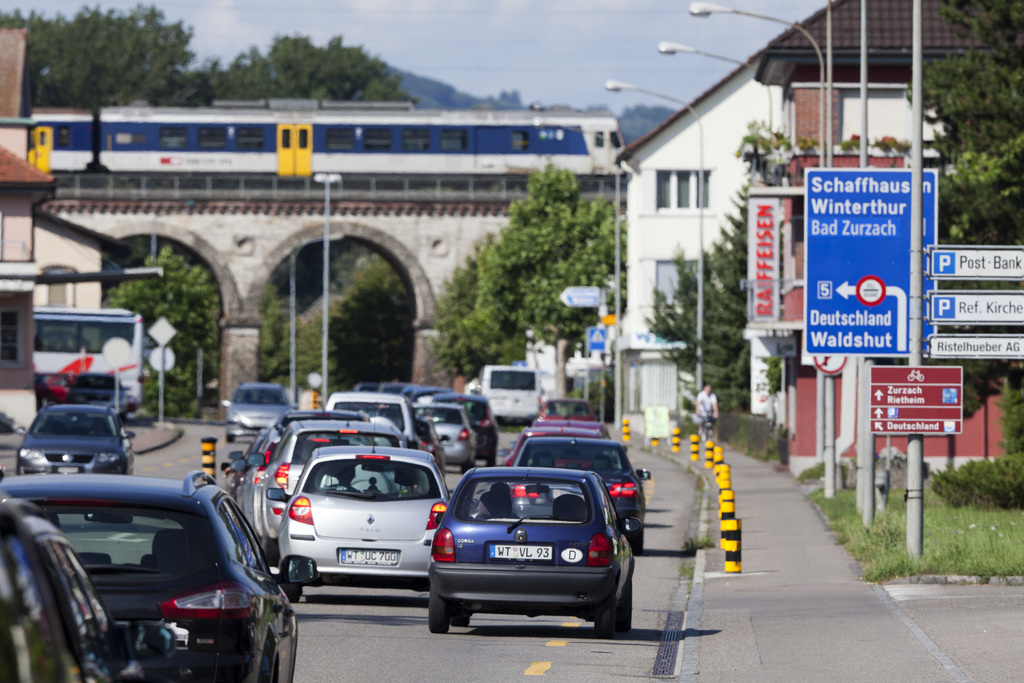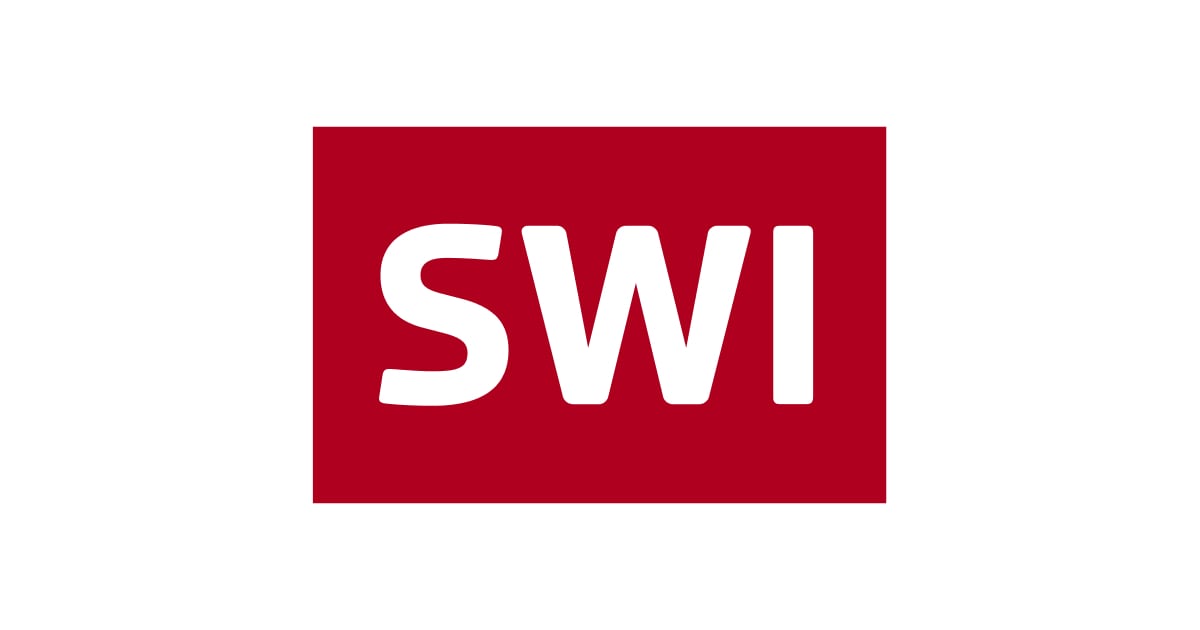
Border towns feel squeeze from trucks and shoppers

Turn a corner in the village of Koblenz and you’ll see cars and ten-wheeler trucks backed up waiting to enter or exit Germany, blocking the idyllic view of the Rhine River. It’s one of many Swiss border towns struggling to cope with growing traffic.
A combination of transport trucks, commuting workers from abroad and Swiss shopping tourists is creating headaches for the authorities, not to mention citizens, in these towns.
At the Koblenz-Waldshut border, for example, some 13,000 cars and 1,000 trucks cross the border each day, leading to daily traffic jams in both Germany and Switzerland. Authorities are currently altering the routing of the traffic and erecting a new customs building at that border in an attempt to reduce the impact of the traffic problem.
The mayor of Koblenz, Heidi Wanner, believes her town and its 1,600 inhabitants are not getting a fair deal. She points to the steady rise in customs income at the Koblenz border, which climbed to CHF304 million ($348 million) in 2012 from CHF97 million in 2001, much of it linked to the transport trucks. While Koblenz does not receive a share of the customs’ revenue, it does have to deal with the fallout from the traffic chaos, Wanner points out.
“Others profit,” said Wanner in her office at the Koblenz town council. “The Swiss federal government [with its customs takings] and the [German] city of Waldshut profit, and we merely pay for it” in terms of traffic and the toll on the village’s image.
Several factors are to blame for the increasingly long line-ups at border cities like Koblenz. The free movement of people accord with the European Union has led to an increase in the number of people commuting to jobs across the Swiss border. How this will be affected by Swiss voters’ recent adoption of immigration curbs and the renegotiation of the accord remains to be seen. (See infobox)
Some 278,534 people living in neighbouring countries worked in Switzerland as of the last quarter of 2013, compared with 179,400 in 2006. Indeed, Wanner says the traffic jams in Koblenz are worst between 4pm and 6pm, when German workers make their way back home from jobs in Switzerland, and Saturdays when people go shopping after receiving their salaries.
Switzerland is also a major European crossing point for trucks, with more than 20,000 crossing the Swiss border every day in 2013, according to a recent report from the Swiss Customs Administration.
Voters approved an initiative by the Swiss People’s Party initiative by 50.3% on February 9, 2014. The initiative calls for a fundamental change in Switzerland’s immigration policy, notably the re-introduction of immigration quotas, which is incompatible with a bilateral accord between Switzerland and the EU on the free movement of people in force since 2002.
The government has until 2017 to implement the immigration curbs. It promised to present a bill to parliament before the end of this year.
The initiative also stipulates that Switzerland will have to renegotiate its bilateral accord with the EU on the free movement of people within three years or revoke it. This in turn could threaten other bilateral agreements with the EU.
Following the outcome of the vote, the Swiss government suspended the ratification of a treaty extending the free movement of people accord to Croatia, an EU member state.
In turn, Brussels suspended talks on a bilateral electricity accord, participation in EU education and research programmes as well as film productions, pending further information from Switzerland about its future EU policy.
CO2 shopping
Cross border shopping is also adding to the traffic congestion as the weaker euro has made this option more appealing in recent years. In 2013, Swiss customs collected CHF39.2 million from Swiss shopping across the border.
A recently released survey on behalf of the Interest Group of the Swiss Retail Trade found that Swiss shoppers spent nearly CHF10 billion abroad in 2013, including in online shops. It reckons that the Swiss drove 1.16 billion kilometres last year to go shopping abroad.
“This corresponds to 214,600 tonnes of carbon dioxide emissions – comparable with that of a city of 35,000 inhabitants – and consequently puts a strain on the environment and infrastructure,” the retail interest group said in a statement in February.
In Basel, Swiss shopping tourists account for some 42% of the 19,000 passenger journeys by car across the Weil am Rhein-Friedlingen border each workday. In response, Basel is building a new tram line – Tram 8 – that the city believes could shift 1,500 of those car journeys each day to public transport, helping reduce the traffic jams in the affected neighbourhoods, according to Marc Keller, spokesman for Basel’s construction and transport department.
The new tram will be the first to travel between the two countries since World War Two. The federal government and canton of Basel are financing the bulk of the CHF104 million price tag for the new line, with German authorities contributing some CHF21.6 million.
Switzerland and Germany also shared the CHF3.3 million costs of the customs site that had to rebuilt with the tracks for the new tram line running along both sides of the building. The new customs facility opened last year, and Tram 8 is slated to start running at the end of 2014. Basel’s plan is to widen the city’s public transport network with its neighbours in coming years, according to Keller.
“The tram network will be expanded to some other locations in coming years in order to take account of the dynamic development” of the Basel agglomeration that is spread across Switzerland, Germany and France, Keller wrote in an email.

More
Mapping Switzerland’s cross-border commuters
Blocking ambulances
Daily traffic jams at the border don’t just impact cities bordering Germany. In Geneva some 65,000 workers cross the border daily, while another 60,000 cross from Italy into the Swiss canton of Ticino. In both areas, that represents a doubling of cross-border workers in a decade.
In the German town of Constance, a favourite shopping spot for Swiss tourists, authorities are considering various options to address their traffic issues, including water taxis and gondolas.
The number of Swiss shoppers visiting Constance has risen steadily in recent years. One indication is the number of green slips, or value-added tax refund forms, stamped at German customs, which rose to two million in 2012 compared with 1.13 million in 2006, according to Walter Rügert, a spokesman for the city.
“It’s clear that many people come here with their cars; we observe that through the full parking lots and on the weekend when the city is full of cars,” Rügert said.
Constance has already taken measures to address the issue. In November, working with officials in the neighbouring Swiss city of Kreuzlingen, Constance closed the border crossing at the Kreuzlingerstrasse to cars. The level of traffic in that neighbourhood had become so severe that ambulances and other emergency personnel couldn’t get through anymore, according to Rügert. The city will analyse data after Easter and decide with Kreuzlingen officials how to proceed with that border crossing.
As part of the Schengen agreement, Switzerland has done away with the systematic control of passports at border points but customs requirements are still in effect.
Travelling by land or water between Switzerland and its neighbours has been simplified with the country’s entry into the Schengen area, a group of European nations that are now covered by a single visa.
That has made systematic passport checks at most crossings no longer necessary. (Airports represent the only border points with non-Schengen area nations, meaning passport and customs controls may take place).
To clarify the origin and destination of goods, border agents may carry out passport checks anywhere. Generally people are allowed to bring in goods worth CHF300 per person duty free, excluding goods like meat, tobacco and alcohol, which are governed by separate rules.
Boosting the economy
Constance has also opened up a new parking lot with 500 spots outside the city core. Shoppers are transported into the centre via a shuttle. Rügert admits that many shoppers still drive into the city to see if they can find a spot before returning to the new parking lot. A decision on other alternative traffic solutions, including the water taxis and gondola will be made by the end of this year.
“No one likes to be stuck in traffic,” Rügert said. “The situation is a challenge for the city, but we are in the process of finding a solution.”
Nevertheless, Rügert stresses that Constance is happy to welcome the Swiss shoppers, who help boost the overall economy.
Wanner, the mayor of Koblenz, is less cordial when it comes to the border crossers. She is looking forward to construction work this summer, which will close the town’s border crossing for three months. Koblenz will, for a time, return to being a quiet Swiss village.
“For a short time, things will be really wonderful,” said Wanner. “You expect traffic jams in big cities like Baden or in Zurich, but in the countryside you shouldn’t be stuck in traffic.”

In compliance with the JTI standards
More: SWI swissinfo.ch certified by the Journalism Trust Initiative






























You can find an overview of ongoing debates with our journalists here . Please join us!
If you want to start a conversation about a topic raised in this article or want to report factual errors, email us at english@swissinfo.ch.